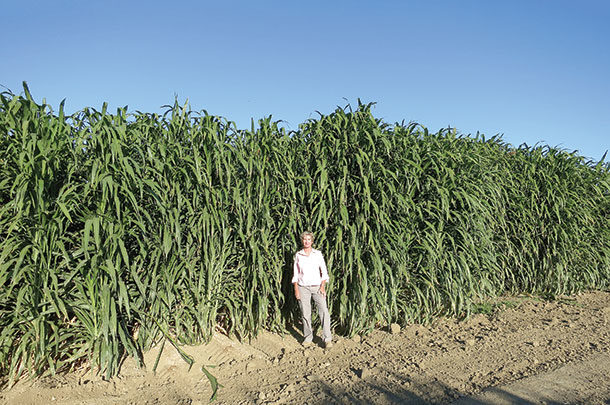California dairy farmers are now in their fourth year of drought, and this has led to more forage sorghums being planted in the state.
Forage sorghums can tolerate drought stress better than most other forage crops and respond well to limited- or deficit-irrigation strategies farmers can employ to save some water.
However, like many forage producers that have been growing predominantly corn for silage, producers can make the mistake of thinking forage sorghums can and should be treated the same as corn.
Sorghum is an old crop in California, having been introduced in 1847 as a tall, grain-producing crop for animal feed. Back in the early 1960s, more than 400,000 acres of grain sorghum were produced in California, and it led the nation in average yields. Since then, more profitable fruits and vegetables have replaced it, and corn silage became the predominant forage for the dairy industry.
So what makes sorghum different than corn? First and foremost is the diversity of sorghum compared to corn. For the most part, you have corn for grain or silage, and the two are somewhat interchangeable.
Sorghum is made up of a complex set of hybrids and uses. These include hybrid grain sorghums, hay-type sorghums (referred to as sudans, sudangrass, or sudangrass x sorghum hybrids), sweet sorghums used for molasses or syrup production, grazing sorghums, forage sorghums (used primarily for silage) and, more recently, biomass sorghums used as feedstocks for renewable fuels.
 A research plot is harvested at Kearney Agricultural Research and Extension Center. Note the contrast in the sorghum types.
A research plot is harvested at Kearney Agricultural Research and Extension Center. Note the contrast in the sorghum types.Because of this diversity, sorghum seed companies developed robust, dedicated breeding programs working to improve sorghum forages.
Over the course of 50 years, researchers have introduced into different forages drought tolerance, improved nutritional quality, height and maturity genes, BMR genetics that improved digestibility and, more recently, brachytic genes that help BMR forages with lodging issues. The sorghum forages of your youth are much different than they are today.
There are several types of sorghum used for forage. There are dual-purpose sorghums that produce both high-tonnage biomass and high grain yields. There are different maturity types as well, such as early, medium or late forages, which all have to do with when the plant flowers. These forages might produce large panicles with a lot of grain or small panicles with little to no grain.
There are also photoperiod-sensitive sorghums, which for the most part will not flower when planted in the U.S. and will produce copious amounts of high-tonnage forage. All these can be used to produce silage, and all require somewhat different management strategies to produce good, nutritious feed.
All these different sorghum types require different management strategies when compared to corn produced for silage. Sorghum seed is small, so it needs to be handled differently from planting to utilization. Unlike corn, sorghum seed numbers can vary wildly per pound, and this is exceptionally important to understand when planting.
A pound of sorghum may contain anywhere from 10,000 to 18,000 seeds per pound, which influences the number of plants per acre. So it is extremely important to understand how many plants per acre you are wanting to plant, and this varies depending upon the hybrid being planted.
 This high-tonnage sorghum was grown in Oklahoma. Photos courtesy of Jeff Dahlberg.
This high-tonnage sorghum was grown in Oklahoma. Photos courtesy of Jeff Dahlberg.
A seeding rate of 80,000 to 120,000 generally works well for silage production. It is critical that farmers use sorghum plates for their planters in order to avoid skips and doubles in their planting pattern.
When sorghum is harvested for either grain production or silage production, its small seed size requires a bit more processing to ensure the grain is cracked, flaked or processed in order to allow dairy cows to get to the available starch. In corn, because of the seed size, one can get away with not managing the processing of the seed as carefully as one needs to with sorghum.
Sorghum forages don’t necessarily require as much nitrogen as corn silage. Recent studies from the University of Arizona reported that approximately 125 pounds of N was adequate for forage sorghums that don’t produce much grain, and that too much N can be detrimental, in that lodging and other issues can take place.
Sorghum forages also can be managed on less water than most other forage crops, requiring 25 to 30 percent less water than corn, so irrigation and fertility can play an important role in producing forages that are of high quality and that will stand.
Finally, because of the diverse array of sorghums that can be used for forage production, there are different nutritional qualities associated with the different types.
Photoperiod-sensitive forages produce no grain, dual-purpose sorghums can have a lot of grain, and BMR sorghums are highly digestible with lower lignin contents; therefore, each needs to be handled and formulated differently based upon the specific nutritional composition.
Some varieties are every bit as good (nutritionally speaking) as corn; however, variability between varieties is much higher, making variety selection very important.
Understanding sorghum forages is a bit more complex than corn silage, but with a proper understanding of the management and nutritional differences, forage sorghums can be a valuable feed for dairies that require less inputs and water.
For additional information about forage sorghums, visit the United Sorghum Checkoff Program website and look for the planting guides and dairy guides for forages, or visit the UC sorghum website to see what research has been done on forages in California.







